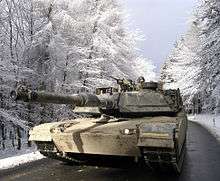Tanks of the post–Cold War era
The post–Cold War era is the period in world history from the collapse of the Soviet Union on December 25, 1991 to the present. During the Cold War (1947–1991), the Soviet domination of the Warsaw Pact led to effective standardization on a few tank designs. In comparison, France, Germany, the United States, and the United Kingdom had previously developed their own tank designs, but now tried to standardize their designs, while the smaller nations of NATO purchased or adapted these designs.
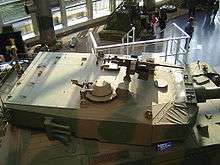
The fall of the eastern bloc brought changes as the United States Military cut much of its expenditure, though the level rose again to comparable heights after the War on Terror started in 2001.[1]
After the Cold War, tank development continued into a third-generation main battle tanks and because of the effectiveness of antitank weapons, the technology advanced dramatically as well. Tanks became more survivable and their armour became thicker and much more effective.
Overview
The main battle tank became the standard as a necessity, as it was realized that smaller medium tanks could carry guns (such as the US 90 mm, Soviet 100 mm, and especially the British L7 105 mm) that could penetrate any practical level of armor at long range. An increasing variety of anti-tank weapons and the perceived threat of a nuclear war prioritized the need for additional armor. The additional armor prompted the design of even more powerful cannons.[2] Typical main battle tanks were as well armed as any other vehicle on the battlefield, highly mobile, and well armored.
Developments in Post Cold War
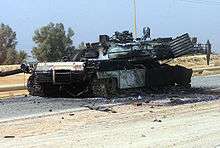
In 1974, the United States initiated an impressive programme to modernise its existing tank fleet and start real mass production of the M60A1, and later the M60A3; at the same time the M1 was developed. Budgets for tank design and production picked up during the administration of president Ronald Reagan, following tensions between the United States and the Soviet Union.
In response to infantry-portable and vehicle-mounted ATGMS, ever more capable defences were developed. Spaced armour, composite, explosive reactive armour, and active protection systems—like the Russian Shtora, Drozd, and Arena—were added to old and new tanks. Despite these improvements the larger missiles remained highly effective against tanks. This was demonstrated in 1991 during the Gulf War when during a friendly fire incident, Hellfire anti-tank missiles disabled several M1 Abrams tanks.
Some of the most successful second-generation Cold War tanks are still in service, indeed, some are still being built! However, they have been extensively upgraded and in some cases overhauled repeatedly and even completely rebuilt during the ensuing decades with layers of enhanced modern armor, newer guns, electronics and brand new and very different engines. Notable examples would be the T-72, Merkava and M1 Abrams. Sometimes these complete overhauls are given a new name, like the Polish Army's PT-91 Twardy based on the T-72M1 (upgrade) which derives from the T-72. So when you see an older tank model listed as current equipment for a modern Army that is still in front-line operational service, check to see if it has a series of numbers and initials after the name. If so, it is probably a tank brought up to third-generation status with little in common to the original other than the shape and the name.
Gulf War/Iraq war
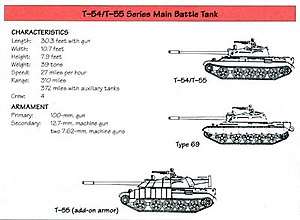
The Gulf War saw the US Marines still charging in with their M60 Pattons while the rest of the tank forces had Abrams. The Iraqi forces were initially regular army units, equipped with tanks such as T-54/55 tanks and T-62s. The Coalition main battle tanks, such as the U.S. M1 Abrams, British Challenger 1, and Kuwaiti M-84AB were vastly superior to the Chinese Type 69 and domestically built T-72 tanks used by the Iraqis, with crews better trained and armoured doctrine better developed.
The majority of Iraq armored forces still used old Chinese Type 59s and Type 69s, Soviet-made T-55s from the 1950s and 1960s, and some poor quality Asad Babil tanks (domestically assembled tank based on Polish T-72 hulls with other parts of mixed origin). These machines were not equipped with up-to-date equipment, such as thermal sights or laser rangefinders, and their effectiveness in modern combat was very limited.
The Iraqis failed to find an effective countermeasure to the thermal sights and sabot rounds used by the Coalition tanks. This equipment enabled them to engage and destroy Iraqi tanks from more than three times the range that Iraqi tanks could engage coalition tanks. The Iraqi crews used training rounds against the U.S. and British tanks. These rounds (purchased in great number during the Iran–Iraq War due to their cheap price) had soft steel penetrators and thus no hope of penetrating the advanced Chobham Armour of the Coalition tanks.
In the Iraqi war in 2003, an Iraqi division the 6th Armored Division of the Iraqi Army.[3] which was equipped with T-55s and BMP-1s defending the control of key bridges over the Euphrates River and the Saddam Canal at Nasiriyah, were decimated by US Marines with M1 Abrams, and the division as a unit rendered incapable for combat during the Battle of Nasiriyah in March 2003, during the invasion.
In addition to the T-54/55 and T-62 tanks that Iraq had, the most feared to US armoured forces were the T-72 tanks in the Iraqi forces. Only Republican Guard divisions were equipped with Iraqi-modified T-72s. Many of the Iraqi T-72s were dug-in or hidden in groves, and then used to ambush the US or British tanks. In the war, the Iraqi T-72s were the preferred target for Apache helicopters and A-10s, in an attempt to diminish the combat power of Republican Guard divisions. The only chance for the Asad Babil T-72s against American tanks was to lure them to close range combat, or trying to ambush them from dug-in positions.[4]
But even in those conditions, the M1s usually prevailed, as proven in circumstances like the Battle of Baghdad, and the drive to the capital, where dozens of Iraqi MBTs were obliterated,[5] or near Mahmoudiyah, south of Baghdad, April 3, 2003, (Iraqi Freedom) when US tanks engaged their counterparts from just 50 yards, shattering seven enemy T-72s without losses.[6] The Lion of Babylon T-72 was utterly outclassed by the M1 Abrams, the Challenger and by any other contemporary Western main battle tank during the 2003 invasion of Iraq.[7]
Post Cold War Main Battle tanks
T-80
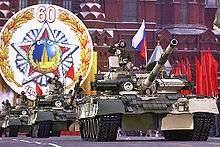
.jpg)
The Russian T-80 is a third-generation main battle tank (MBT) designed and manufactured in the Soviet Union. A development of the T-64, it entered service in 1976 and was the first production tank to be equipped with a gas turbine engine for main propulsion. The T-80U was last produced in a factory in Omsk, Russia, while the T-80UD and further-developed T-84 continue to be produced in Ukraine. The T-80 and its variants are in service in Belarus, Cyprus, Kazakhstan,[8] Pakistan, Russia, South Korea, and Ukraine. The original T-80 design uses a 1,000 horsepower gas turbine instead of a 750-horsepower diesel engine, although some later variants of the T-80 revert to diesel engine usage. The gearbox is different, with five forward and one reverse gear, instead of seven forward and one reverse. Suspension reverts from pneumatic to torsion bar, with six forged steel-aluminium rubber-tyred road wheels on each side, with the tracks driven by rear sprockets.[9] The glacis is of laminate armour and the turret is armoured steel. The turret houses the same 125 mm 2A46 smoothbore gun as the T-72, which can fire anti-tank guided missiles as well as regular ordnance.[9] The tracks are slightly wider and longer than on the T-64 giving lower ground pressure.[9]
The main gun is fed by the Korzina automatic loader. This holds up to 28 rounds of two-part ammunition in a carousel located under the turret floor.[10] Additional ammunition is stored within the turret. The ammunition comprises the projectile (APFSDS, HEAT or HE-Frag) plus the propellant charge, or the two part missile.[10] The autoloader is an effective, reliable, combat tested system which has been in use since the mid-1960s. The propellant charge is held inside a semi-combustible cartridge case made of a highly flammable material – this is consumed in the breech during firing, except for a small metal baseplate.[10]
A disadvantage highlighted during combat in Chechnya was the vulnerability of the T-80BV to catastrophic explosion.[10] The reason given by US and Russian experts is the vulnerability of stored semi-combustible propellant charges and missiles when contacted by the shaped charge jet from the penetration of a HEAT warhead, causing the entire ammunition load to explode.[11]
Leopard 2
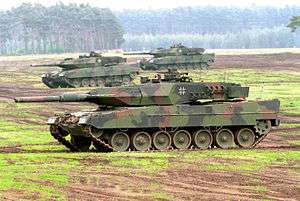
The Leopard 2 is the German main battle tank (Kampfpanzer) developed by Krauss-Maffei that replaced the earlier Leopard 1 as the main battle tank of the German Army. Various versions have served in the armed forces of Germany and twelve other European countries, as well as several non-European nations.[12] The Leopard 2 first saw combat in Kosovo with the German Army and has also seen action in Afghanistan with the Danish and Canadian ISAF forces. Turkey employed the Leopard 2 for its military operations in Syria.
Minor modifications and the installation of the gunner's thermal sight[13] were worked into the second batch of 450 vehicles Leopard 2 designated the A1; 248 by Krauss-Maffei (Chassis Nr. 10211 to 10458) and 202 by Mak (Chassis Nr. 20173 to 20347). Deliveries of the 2A1 models started in March 1982 and ended in November 1983. The two most notable changes were the modification of the ammunition racks to be identical to those in the M1 Abrams, and redesigned fuel filters that reduced refuelling time.
The most widespread version of the Leopard 2 family, the 2A4 models included more substantial changes, including an automated fire and explosion suppression system, an all-digital fire control system able to handle new ammunition types, and improved turret with flat titanium/tungsten armour. All the older models were also upgraded to 2A4 standard.
The 2A4 was also license manufactured in Switzerland as the Panzer 87 "Leopard" or Pz 87. This version included Swiss-built 7.5 mm Mg 87 machine guns and communications equipment, and featured improved NBC protection system. Switzerland operated 380 Pz 87 tanks.
At the turn of the century, Germany and the Netherlands found themselves with large stocks of tanks they had no need for after the end of the Cold War. These tanks were sold to NATO or friendly armies around the world. Among these were Austria, which received 114 vehicles. Canada (107), Chile (140), Denmark (51), Finland (139), Greece (183), Norway (52), Poland (247), Portugal (37), Singapore (96), Spain (108), Sweden (160), and Turkey (339) were among the buyers of the surplus tanks.
Challenger 2
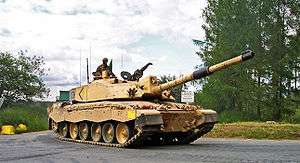
The Challenger 2 is the British main battle tank (MBT) currently in service and was designed and built by the British company Vickers Defence Systems (now known as BAE Systems Land and Armaments).[14]
Challenger 2 is an extensive redesign of the Challenger 1. Although the hull and automotive components seem similar, they are of a newer design and build than those of the Challenger 1, and fewer than 3% of components are interchangeable. Challenger 2 replaced Challenger 1 in service with the British Army and is also used by the Royal Army of Oman. It has seen operational service in Bosnia, Kosovo and Iraq.
In June 1991, after competition with other tank manufacturers' designs (including the M1A2 Abrams and the Leopard 2 (Improved)), the MoD (Ministry of Defense) placed a £520 million order for 127 MBTs and 13 driver training vehicles. An order for a further 259 tanks and 9 driver trainers (worth £800 million) was placed in 1994. Oman ordered 18 Challenger 2s in 1993 and a further 20 tanks in November 1997.
Challenger 2 entered service with the British Army in 1998 (with the 2nd Royal Tank Regiment in Germany), with the last delivered in 2002. It is expected to remain in service until 2035. It serves with the Queen's Royal Hussars, the King's Royal Hussars - which will convert to the General Dynamics Ajax shortly -- and the Royal Tank Regiment, each of which is the tank unit of an armoured infantry brigade.
K-2 Black Panther

The South Korean military introduced the K-2 black panther as the South Korean MoD felt it required a more advanced tank to cope with the growing threat of North Korea; especially in terms of ground combat. The K-2 is one of the most expensive tanks in the world costing at around US$9 million per unit. The South Korean military already fielded the K1/K1A1 tank which was a domestically produced tank and could already dominate North Korean tanks such as the T-55 and the Type 59. However, the K-2 was seen as a development which would see the ROK forces securely dominate the North Korean forces in ground combat.
Unlike the K1 series, the K-2 series is a completely different design. It looks much lighter and mobile and carries a wide range of modern technology that can match and often beat other MBTs out to date. Furthermore, it has many advancements in suspension such as the In-arm suspension which gives it characteristics such as kneeling and crouching which increases its survival rate in combat.
As of 2014, 100 K-2s are already being fielded by the ROK armed forces and a further 106 are set to be completed by 2017. Furthermore, the South Korean MoD agreed to sell the Turkish Armed Forces development details worth US$540 million to aid in their own project in developing the Altay MBT.
As of now, the South Korean military are set to begin development of the K-2 PIP which is to be an upgrade of the current K-2 model with further advancements in aspects such as armour, weaponry and optics such as a hard-kill APS.
Merkava Mark III and IV
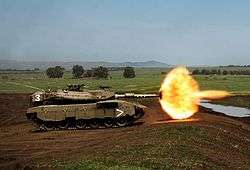
The Israel Defense Forces Merkava Mark III was introduced in December 1989, and had upgrades to the drivetrain, powertrain, armament, and electronic systems. The most prominent addition was the incorporation of the locally developed IMI 120 mm gun.[15] This gun and a larger 1,200 horsepower (890 kW) diesel engine increased the total weight of the tank to 65 tonnes (143,000 lb), but the larger engine increased the maximum cruising speed to 60 km/h (37 mph).[16]
The turret was re-engineered for movement independent of the tank chassis, allowing it to track a target regardless of the tank's movement.
The next development was the Israel Defense Forces Merkava Mark IV tank which is the most recent upgrade of the Merkava tank and has been in development since 1999. The upgrade's development was announced in an October 1999, however, new Merkava Mark IIIs continued to be produced until 2003. The first Merkava IVs were in production in limited numbers by the end of 2004.[17]
The model has a new fire-control system, the El-Op Knight Mark 4. Removable modular armor, from the Merkava Mark IIID, is used on all sides, including the top and a V-shaped belly armor pack for the underside. This modular system is designed to allow for damaged tanks to be rapidly repaired and returned to the field. The tank carries the Israeli Elbit Systems Battle Management System and an active protection system.
Tank rounds are stored in individual fire-proof canisters, which reduce the chance of cookoffs in a fire inside the tank. The turret is "dry"; no active rounds are stored in it.
Some features, such as hull shaping, exterior non-reflective paints, and shielding for engine heat plumes mixing with air particles to confuse enemy thermal imagers, were carried over from the IAI Lavi program of the Israeli Air Force to make the tank harder to spot by heat sensors and radar.
The Mark IV includes the larger 120 mm main gun of the previous versions but can fire a wider variety of ammunition, including HEAT and sabot rounds like the APFSDS kinetic energy penetrator, using an electrical semi-automatic revolving magazine for 10 rounds. It also includes a much larger 12.7 mm machine gun for anti-vehicle operations (most commonly used against technicals).[18]
Type 90 tank
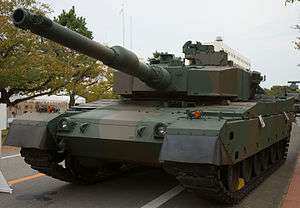
The Japanese Type 90 tank, main battle tank (MBT) of the Japan Ground Self-Defense Force (JGSDF) as of 2011 was designed and built by Mitsubishi Heavy Industries as a replacement for all deployed Type 61 and Type 74 tanks, and entered service in 1990.
With the exception of the 120 mm smoothbore gun, which is made under licence from Rheinmetall of Germany, the Type 90 and its subsystems are all designed and built in Japan, leading to higher per unit costs for comparable models from NATO countries such as the M1 Abrams and the Challenger 2.
The profile of the Type 90 is similar to the original German Leopard 2 without the sloped armor, (Leopard 2 to 2A4) but unlike the Leopard 2, the Type 90 uses modular ceramic and steel composite armor,[19] common in contemporary post-1990s tank designs. The adoption of modular composite armor design facilitates the upgrading and exchange of the armor, and its frontal armor is tested to be effective against JM-33 120 mm APFSDS projectiles from the L44 gun, while the side armor of the turret is capable of defeating up to 35 mm APDS (Armor penetration of 90 millimeters of RHA at one kilometer) projectiles.
The Type 90 is smaller than most main battle tanks with a height of 2.33 meters, a width of 3.33 meters, and weighing in at 50.2 tonnes.
Type 10
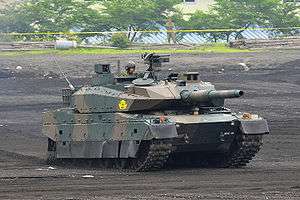
The Japanese Type 10 (10式戦車, Hitomarushikisensha) is a 4th generation main battle tank produced by Mitsubishi Heavy Industries for the Japanese Ground Self Defense Force (JGSDF). Compared with other currently-serving main battle tanks in the JGSDF, the Type 10 has been equipped with enhancements in its capability to respond to anti-tank warfare and other contingencies.[20]The tank is smaller and rather light for a modern MBT being in the 40+ ton class; specifically designed not to over stress the many bridges one encounters and allow it to maneuver on the small roadways in Japan. The Type 10 is to replace the existing 40-year old 2nd generation Type 74 and/or complement the heavier 3rd generation Type 90 main battle tanks that are currently in service. Development began in the 1990s, with a prototype revealed in February 2008.
In January 2012, thirteen Type 10 tanks entered JGSDF service. The vehicle's armor consists of modular components which significantly improves the side armor compared to the Type 90. While the Type 10 uses a smoothbore gun barrel of the same 120 mm diameter and L44 length as the Type 90's license-built Rheinmetall Rh-120 gun, the Type 10's gun is a brand new indigenous design which is also made by Japan Steel Works.[21] This is the only gun capable of firing Japan's newly developed APFSDS type of tank round, known as the: Type 10 APFSDS. The Type 10 tank gun is capable of firing the existing: JM33 APFSDS, as well as all standard 120 mm NATO ammunition. However, the newly developed Japanese: Type 10 APFSDS ammunition, is specifically designed for and can only be fired by the Type 10's gun.[22]
AMX Leclerc
The AMX Leclerc is the French main battle tank (MBT) built by GIAT, now Nexter of France. It was named in honour of General Philippe Leclerc de Hauteclocque who led the French element of the drive towards Paris while in command of the Free French 2nd Armoured Division (2ème DB) in World War II.
The Leclerc is equipped with a GIAT (Nexter) CN120-26 120 mm smoothbore cannon. This cannon is capable of firing the same NATO standard 120 mm rounds as the German Leopard 2 and US M1 Abrams, but in practice only French-produced ammunition is issued. The gun is insulated with a thermal sleeve and has an automatic compressed-air fume extraction system instead of the usual bore evacuator. The Leclerc has a unique autoloading system which was specifically designed for it, and reduces the crew to three by eliminating the human loader. The turret of the Leclerc was designed around the auto-loading system in order to avoid the problems common to other tanks with an autoloader. The Leclerc autoloader allows a rate of fire of 12 shots per minute and holds 22 rounds of ready ammunition; it can accommodate up to six different types of ammunition at once, although like most autoloader systems it cannot change ammunition types once a round has been loaded. The most common types are the armour piercing fin-stabilised discarding sabot (APFSDS) with a tungsten core and the high explosive anti-tank (HEAT) round. There are 18 other rounds available for reload. A Leclerc tank can fire while traveling at a speed of 50 km/h on a target 4,000 metres away. The gun is 52 calibres long instead of the 44 calibres common on most tanks of the Leclerc's generation,[13] giving the rounds a higher muzzle velocity.
The Leclerc is also equipped with a 12.7 mm coaxial machine gun and a remote-controlled 7.62mm machine gun, whereas most other NATO tanks use 7.62mm weapons for both their coaxial and top machine gun mounts; the major exception is the American M1 Abrams, which has a 7.62mm coaxial machine gun and two top-mounted machine guns, one 7.62mm and one 12.7mm.
The Leclerc has the GALIX combat vehicle protection system from GIAT, which fires a variety of smoke grenades and infra red screening rounds, as well as anti-personnel grenades.
The hull and the turret are made of welded steel fitted with modular armour, which can be replaced easily for repair or upgraded over the years. The French army in the late seventies rejected Chobham armour as being overly specialised in its optimisation to defeat hollow charge-weapons; it therefore opted to develop their own composite arrangement to defeat both hollow charge and sabot round. Due to the introduction of modernized threats, the batch 3 has a new armour package, including composite armor, titanium insert and on the sides of the turret, ERA blocks.
In service only since 1992 (after the Persian Gulf War), the Leclerc has no notable experience in true warzone environments, but has seen deployment on multiple low-intensity conflicts, including 15 Leclerc stationed in Kosovo (KFOR) and others in Lebanon (UNIFIL) in the context of UN peace-keeping operations, where their performance was judged satisfactory by French officials.
Until 2010, 13 Leclerc were deployed in the south Lebanon for a peacekeeping mission with UNIFIL.
C1 Ariete
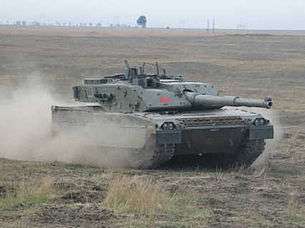
The C1 Ariete is the main battle tank of the Italian Army, developed by a consortium formed by Iveco-Fiat and Oto Melara (aka CIO, Consorzio Iveco Oto Melara). The chassis and engine were produced by Iveco, while the turret and fire-control system were produced by Oto Melara.The Ariete is mounted with a 120 mm smoothbore Oto Melara cannon, autofrettaged and stress-hardened to increase durability over extended periods of fire, allowing the use of APFSDS and HEAT rounds.
The Ariete's armour is a steel and composite blend, similar to the British Challenger 2 and the American M1 Abrams.
The Ariete features two side-mounted, electronically fired grenade launchers. Each launcher consists of four barrels which can be intermixed with either smoke or chaff grenades. The smoke grenades are capable of shrouding the tank from visual or thermal detection, while the chaff grenades disperse the tank's radar cross section. The tank is fully NBC protected.[23]
Arjun
The Arjun (Sanskrit: अर्जुन) is India's third generation[24][25] main battle tank developed by India's Defence Research and Development Organisation (DRDO), for the Indian Army. The tank is named for Arjun, a character in the Indian epic, Mahabharata.
The Arjun features a 120 mm main rifled gun with indigenously developed APFSDS ammunition, one 7.62 mm coaxial machine gun, and a 12.7 mm machine gun. It is powered by a single MTU multi-fuel diesel engine rated at 1,400 hp, and can achieve a maximum speed of 70 km/h (43 mph) and a cross-country speed of 40 km/h (25 mph). It has a four-man crew: commander, gunner, loader and driver. Automatic fire detection and suppression and NBC protection systems are included. All-round anti-tank warhead protection by the newly developed Kanchan armour is claimed to be much higher than available in comparable third generation tanks.[24]
Al-Khalid
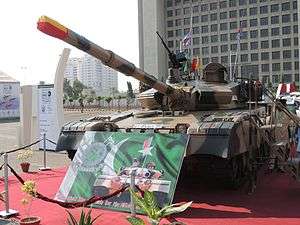
The Al-Khalid tank (Urdu: الخالد ٹینک—Al-Xālid Ṫaiŋk, pronounced [əl-ˈxɑːlɪd̪ ʈæːŋk] lit. The Immortal Tank) and MBT-2000 refers to the main battle tank of Pakistan of jointly developed variants made by Pakistan and China during the 1990s. About 300 Al-Khalid tanks were in service with the Pakistan Army as of 2009. 44 MBT-2000 is in service with Bangladesh Army from 2011.
Operated by a crew of three and armed with a 125 mm smooth-bore tank gun that is reloaded automatically, the tank uses a modern fire-control system integrated with night-fighting equipment and is capable of firing many types of anti-tank rounds as well as guided anti-tank missiles.[26] Al-Khalid is named after the 7th-century Muslim commander Khalid bin al-Walid (592–642 AD).[27][28]
An evolution of Chinese and Soviet tanks, the design is considerably smaller and lighter than most Western main battle tanks. It is based on the Chinese Type 90-II, which combined technologies from several Soviet and Western tanks.[26] The Al-Khalid is unusual in that it was designed to be adaptable for manufacture, so that it can be easily integrated with a variety of foreign engines and transmissions. The current production variant of the Al-Khalid uses a diesel engine and transmission supplied by the KMDB design bureau of Ukraine.[29] The first production models entered service with the Pakistan Army in 2001.
Type 99
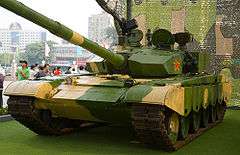
The Chinese Type 99 tank (Chinese: 99式; pinyin: Jiǔjiǔ shì), also known as ZTZ-99 and WZ-123, was developed from the Type 98G (in turn, a development of the Type 98), is a third generation main battle tank (MBT) of the Chinese People's Liberation Army. It is made to compete with other modern tanks and is currently the most advanced MBT fielded by China.
Small-scale production of the Type 98 was begun in time for the tank to be featured in the PRC's National Day parade in 1999.
Following the completion of the Type 98, research into improved versions of the tank continued within the Chinese government. These programs produced the Type 98G, a refined iteration of the Type 98 with a better reliability record. At the end of 2001, the first batch of 40 Type 98G tanks entered service with the regular Army. The Type 98G eventually gave rise to what is now known as the Type 99, which was officially revealed by the government in 2001. The final version of the Type 99 included a 1,500-horsepower engine, as opposed to its immediate predecessor's 1,200-horsepower powertrain. Also added were a Leopard 2A5-style sloped-arrow armor plate on the front of the turret, and additional composite armor layers on the sides.
In part due to its high cost, the tank is not expected to be deployed in large numbers, unlike earlier Chinese designs such as the Type 59. Because of the limited nature of its production, the Type 99 is currently only operated by the PLA's most elite divisions.
Altay
The Turkish Altay is a main battle tank, designed and developed by Otokar of Turkey for the Turkish Army and export markets.[30][31][32] It is named in honor of Army General Fahrettin Altay (1880–1974)[33] who commanded the 5th Cavalry Corps in the final stage of the Turkish War of Independence.
The Altay was designed from 2008 until 2012. Weighing in 65 tons it is one of the most heavy MBTs in service. 4 are actually in service and a total of 1,000 MBTs are planned to be produced in four separate lots of 250 units. The Altay needs a crew of 4 – commander, gunner, loader & driver. No autoloader is present. This machine features ROKETSAN (armour package)[34] composite armour and the Aselsan/STM Volkan III assisted MKEK 120 mm 55 caliber smoothbore gun capable of firing standard NATO ammunition.
The Altay will compete on the Turkish army contract estimated at $2B for a batch of 250 tanks. Three more similar batches are expected.[35]
Karrar
The Iranian new MBT. The tank was announced on 12 March 2017. At the announcement, it was stated that it possessed an electro-optical fire control system, a laser rangefinder, ballistic computer and could fire at both stable and mobile targets in day or night.[3]
Main armament of the Karrar consists of one 125mm smoothbore gun fitted with a fume extractor and a thermal sleeve. A remotely operated weapon station armed with a 12.7mm machine gun is mounted on the roof of the turret. The main gun is able to fire anti-tank laser-guided missiles.
Oplot
The newest Ukrainian main battle tank (MBT) and most sophisticated version of the T-84 is an upgraded version of the "T-84 Oplot" mounting more advanced armor, new electronic countermeasure systems, and others from KB Yugnoe. One visible feature is the new PNK-6 panoramic tank sight. It has been used since 2014 in the war against Russia in territories annexed from the Ukraine by Russia. It is believed a very effective tank against old ex-soviet tanks.[36]
See also
References
- Citations
- Shah, Anup. "World Military Spending — Global Issues". Globalissues.org. Retrieved 2013-09-21.
- Front Cover Thomas W. Zarzecki (2002). Arms diffusion: the spread of military innovations in the international system. Psychology Press. p. 212. ISBN 0-415-93514-8. Retrieved 5 April 2011.
- Lee, R. J. Key Components of the Iraqi Ground Forces, 2002
- Scales, page 269: "As TF 1-37th Armor crossed over the ridge into the heart of the Iraqi defensive zone, the Iraqi commander's carefully disposed rear-slope defense stripped Dyer's tanks of their range advantage. Within 1,000 meters, a row of dug-in T-72s and BMPs suddenly appeared below the crest. All were hull-down in prepared positions behind thick dirt walls (thus disproving the much-quoted u.s. truism that soviet tanks had difficulties in achieving 'hull down' position). Now the Americans were well within Iraqi killing range, and although the Soviet-made night sights were markedly inferior, things could still get very dicey."
- Scales, page 270: "After the war they (TF 1-37th) returned to count the burned-out hulks of 76 T-72s, 84 BMPs, 3 air defense artillery pieces, 8 howitzers, 6 command vehicles, 2 engineer vehicles, and myriad of trucks."
- Conroy & Mars, p. 158
- ТАНКИ ИРАКСКОЙ АРМИИ [Iraqi Army Tanks]. otvaga2004.narod.ru (in Russian). December 29, 2009. Archived from the original on September 5, 2009.
- Kolekcja Czołgi Świata, Issue 8
- Foss (2005), pp. 89–90.
- Warford (1995), pp. 18–21.
- Zaloga, Steven J. (2011). T-80 Standard Tank: The Soviet Army's Last Armored Champion. Oxford, UK: Osprey Publishing. p. 31. ISBN 1-78096-148-0.
- Jerchel, Michael (2012). Leopard 2 Main Battle Tank 1979–98. Oxford, UK: Osprey Publishing. pp. 3–7. ISBN 17820-0695-8.
- Gelbart, Marsh (1996). Tanks: Main Battle and Light Tanks. Brassey's UK Ltd. pp. 109–110. ISBN 978-1-85753-168-8. OCLC 36171829.
- "Products & Services Challenger 2". BAE Systems. 14 February 2008. Archived from the original on 21 June 2007. Retrieved 2011-01-16.
- "Israel Military Industries 120 mm smoothbore tank gun MG251 (Israel)", Armour and Artillery Upgrades, Jane's.
- "Merkava Mk 3". Tanks. Israeli Weapons. Retrieved 2008-07-04.
- Donald, David (14 June 2010), "Merkava Mk IV breaks cover", Euro satory, Jane's.
- "Merkava Mk4 Detailed". Defense Update. Archived from the original on 2014-04-26.
- Photo of Type 90
- Introduction of the aircraft Type 10 tank -Japanese Ministry of Defense, Japan Defense Focus No.33 Column, Oct 2012
http://www.mod.go.jp/e/jdf/no33/column.html - "Type 10 Tank of Japan Ground Self Defense Force". Global Military Review. Retrieved 3 April 2015.
- Japanese MOF report
- Aero Sekur
- "On track with today's top tanks". Army Technology. Retrieved 4 August 2013.
- "A Look at Indian Army's Main Battle Tanks". India TV. 6 March 2013. Retrieved 4 August 2013.
- Foss, Christopher (22 November 2000). "Al Khalid MBT to enter production". Retrieved 15 April 2013.
- "Modernization of Al-Khalid tank: Ukraine to provide technical cooperation to Pakistan: envoy". Business Recorder. 20 October 2011. Retrieved 27 June 2013.
- Aqeel Abbas Jafari (2010). Pakistan Chronicle (in Urdu) (1st ed.). 94/1, 26th St., Ph. 6, D.H.A., Karachi: Wirsa Publications. p. 688. ISBN 9789699454004.CS1 maint: location (link)
- "Ukraine to Deliver 110 Battle Tank Engines to Pakistan | RIA Novosti". RIA Novosti. 2013-02-18. Retrieved 2013-06-19.
- "Altay | Tracked Armored | Military Vehicles | Products". Otokar. Retrieved 2015-02-28.
- "Altay Tank" (PDF). Roketsan.com.tr. Retrieved 2015-02-28.
- "Otokar'ın en önemli projesi 'milli tank Altay' haberi Dünya.com'da". Dunya.com. 2014-03-22. Retrieved 2015-02-28.
- "Milli tank 'altay' için yola çıkıldı – Ekonomi Haberleri". Radikal. 2008-07-30. Retrieved 2015-02-28.
- "Altay MBT". Military Factory. Retrieved 8 April 2014.
- "Local tank production contract litmus test for Koç's defense business". 5 August 2014.
- Archived November 29, 2009, at the Wayback Machine
